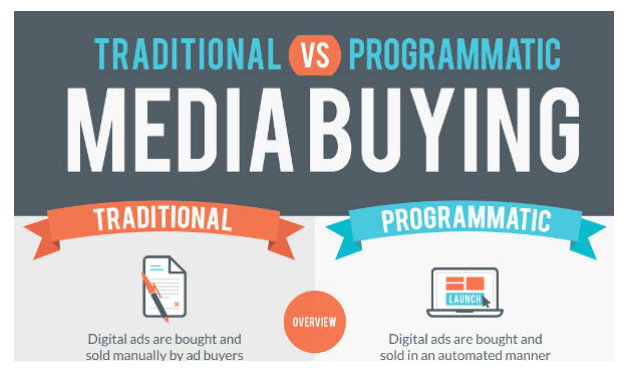Overview
We live in a digital age where we do almost everything online; advertising, marketing, promotions – you name it. Digital marketing is the order of the day.
One dominant form of digital advertising is programmatic ads. If your business uses online ads, then there’s a chance you’d have heard about programmatic.
But if you’re clueless about what it is, here’s your chance to find out.
What is programmatic?
Definition of Programmatic Ads

Image Source: Toprankblog
Programmatic advertising is defined as the automatic management of online ads. Instead of manually purchasing ad sales, you use software to automate and speed up the process of buying and selling.
You acquire digital media through an online exchange using Real-Time Bidding (RTB).
Traditionally, the process involved placing requests for proposals (RFPs), tenders, manual insertion orders, and human negotiations. But now programmatic purchase uses machines and algorithms to buy display space.
Programmatic doesn’t necessarily eliminate the ad-buying process. What it does is reduce the workload involved and allows for optimization and improvement of the ads.
When Should You Use Programmatic Ads?
Programmatic ads are considered a major component of modern advertisement. Earlier this year, US advertisers were projected to spend about $60 billion on programmatic display. Estimations reveal the amount would increase to around $84 billion or more by 2021.
Programmatic Marketing Forecasts reveal how 65 percent of all money spent on ads in 2019 will be traded programmatically.
Image Source: Chatsbotsmagazine
It can be reasonably easy determining when to use a particular technique for some advertising methods. Programmatic advertising, on the other hand, tends to be trickier. While programmatic will produce results in almost any situation, it excels in building brand awareness and influencing consideration.
Building Brand Awareness
Branding and creating awareness for your company is a crucial step to make – especially when your business is new. Your goal at this point is letting potential customers know what you have to offer. Doing this requires spreading your message to a large group of users across various platforms.
Adopting the manual approach would not only cost a lot of money but also require a lot of time. Using programmatic digital media and RTB will simplify the process and reach a larger audience.
Influencing Consideration
Programmatic supports various forms of advertisement, including traditional display ads using images, audios, or videos. These forms of advertising show the value of your brand when trying to increase its consideration.
On the one hand, programmatic help you communicate complex messages while teaching users the advantages of using your brand. And on the other hand, it allows you to maintain the benefits of the program, such as a broad reach and cost-effective engagements.
Programmatic Terms to Note
Real-Time Bidding (RTB)
RTB occurs when ad inventory is purchased on a ‘per view’ basis in real-time using programmatic ads.
Demand-Side Platforms (DSPs)
DSPs are platforms that let the user (advertisers) manage their ad and data exchange accounts.
Supply-Side Platforms (SSPs)
SSPs are platforms that let the user (publishers mostly) manage their available ad inventory space.
Data Management Platform (DMP)
DMP acts as the data storage, analysis, and management platform for marketing and ad campaigns.
Ad Exchange
It serves as a marketplace for buying and selling ad inventory through bidding and real-time auctions.
Viewability
Viewability is the metric that tracks the number of views or impressions made by the programmatic ad.
How Programmatic Ads work

Image Source: Bannerflow
Step One: A user lands on a site using programmatic. The software starts the real-time bidding to serve an ad to the particular user.
Step Two: The publisher goes on to list the ad space for the user on their SSP (Supply-Side Platform). The SSP serves as the seller and informs advertisers of the characteristics of the site, viewer, and ad space.
Step Three: After receiving the info on the ad space, the SSP analyses the viewer’s cookie to determine geography, interests, demographics, etc.
Step Four: The Demand-Side Platform (DSP) reviews the information the SSP provided on the user. The DSPs act for the advertisers in choosing ad space that aligns with their budgets and targets.
Step Five: The DSP places a bid on the ad placement on behalf of the advertiser (It all happens in real-time).
Step Six: After receiving bids from various DSPs, the SSP goes on to select the winner.
Step Seven: After choosing the winning bid, the SSP displays the ad to the viewer on the publisher’s website.
All seven steps occur in milliseconds while the page is loading.
What is the Long-term Value of Programmatic Ads?
Programmatic advertising has shown steady growth since 2016. And since then, companies have continued increasing their programmatic ads investment. Analytics predict even more growth in the coming years.
These developments show the value and impact that programmatic has on the businesses that use it and emphasize its longevity.

Image Source: Thinkwithgoogle
So Should You Use Programmatic Marketing?
Yes. Why? Because it works.
Programmatic advertising is an ideal tool and an excellent supplement to marketing campaigns. But first, determine your marketing objectives, capabilities, and specific needs before deciding if programmatic marketing is a good fit for your brand.

